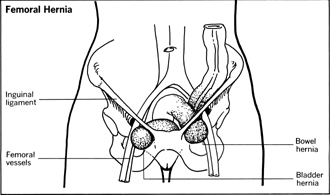Femoral Hernia
Minimally Access Inguinal/Femoral Hernia Repair
(Laparoscopic Inguinal/Femoral Hernia Repair)

In laparoscopic hernia surgery, a telescope attached to a camera is inserted through a small incision that is made under the patient’s belly button. Two other small cuts are made (each no larger than the diameter of pencil eraser) in the lower abdomen. The hernia defect is reinforced with a ‘mesh’ (synthetic material made from the same material that sutures are made from) and secured in position with stitches/staples/titanium tacks or tissue glue, depending on the preference of individual surgeon.
Risks of Inguinal/Femoral Hernia Repair:-

- Any operation may be associated with complications. The primary complications of any operation are bleeding and infection, which are uncommon with laparoscopic hernia repair.
- There is a slight risk of injury to the urinary bladder, the intestines, blood vessels, nerves or the sperm tube going to the testicle.
- Difficulty urinating after surgery is not unusual and may require a temporary tube into the urinary bladder.
- Any time a hernia is repaired it can come back. This long-term recurrence rate is not yet known. Your surgeon will help you decide if the risks of laparoscopic hernia repair are less than the risks of leaving the condition untreated.
How is laparoscopic Inguinal/Femoral Hernia Repair more beneficial?
Most cases of Inguinal/Femoral Hernia can be treated laparoscopically. The main advantages are:
- Less post-operative pain
- Faster recovery and return to normal activity
- Shorter hospital stay
- Less post-operative complications
- Minimally Sized incisions / scares
